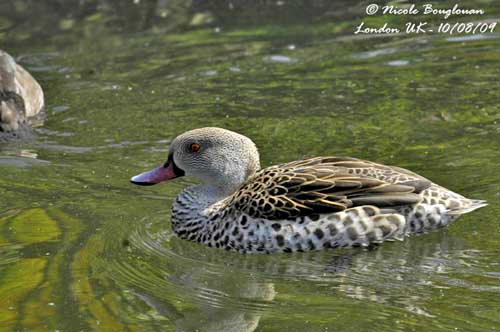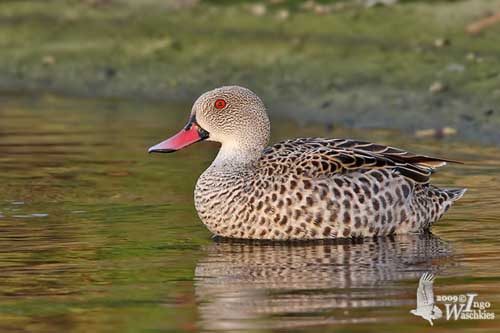
Fr: Canard du Cap
All : Fahlente
Esp : Cerceta de El Cabo
Ital : Alzavola del Capo
Nd: Kaapse Taling
Sd: Kapand
Photographers:
Ingo Waschkies
Bird Photography
Nicole Bouglouan
PHOTOGRAPHIC RAMBLE
Text by Nicole Bouglouan
Sources:
HANDBOOK OF THE BIRDS OF THE WORLD vol 1 by Josep del Hoyo-Andrew Elliot-Jordi Sargatal - Lynx Edicions - ISBN: 8487334105
GUIDE DES CANARDS, DES OIES ET DES CYGNES – de Steve Madge - Delachaux et Niestlé - ISBN: 2603013769
BIRDS OF AFRICA SOUTH OF THE SAHARA by Ian Sinclair and Peter Ryan - Princeton University Press Princeton and Oxford - ISBN: 0691118159
ROBERTS BIRDS OF SOUTH AFRICA by G. R. Mc Lachlan and R. Liversidge – The Trustees of the John Voelcker Bird Book Fund – ISBN: 0620031182
BirdLife International (BirdLife International)
ANIMALS – Explore, discover, connect
Cape Teal
Anas capensis
Anseriforme Order – Anatidae Family
BIOMETRICS:
Length: 44-48 cm
Wingspan: 78-82 cm
Weight: M: 420g - F: 380g
DESCRIPTION:
The Cape Teal is a small, stocky tropical African duck with pale plumage.
The adult has pale grey head, neck, underparts, tail, tail-coverts and rump, finely spotted black-brown on head and neck, and with larger dark spots on the body. We can see a thin crest on the nape.
The upperparts are dark brown with buff-reddish-edged feathers. Wings are dark brown. Primaries are dark, secondaries are metallic grey-black with white tip, and greater coverts show broad white terminal bands, and green, edged white speculum.
The bill is pink with black tip, black markings at base and blue-green towards the tip. The eyes are variable, yellow, orange or brown. Legs and webbed feet are yellowish-brown with black webs.
The female shows smaller spots on breast. The bill is paler. The head is darker and the crest is absent.

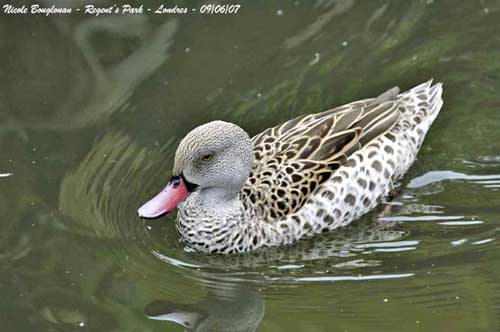
The juvenile is duller, with more uniform plumage. The bill is paler than in adults.
The chicks have grey-brown upperparts with whitish spots on back and whitish underparts. Face is whitish with grey eye area and greyish breast band. Bill and legs are pinkish.
VOICE:
The Cape Teal is usually silent, but it becomes more vocal during the breeding season. The male has sharp, nasal voice, but it sometimes gives a high-pitched, clear whistle “swii-tsiiu”. The female gives a loud and nasal “querck”.
HABITAT:
The Cape Teal frequents shallow lagoons with saline or brackish waters. It can be found seasonally in wetlands, reservoirs, marshes, rivers and coasts.
RANGE:
The Cape teal is found in Sudan and Ethiopia to Namibia and South Africa.
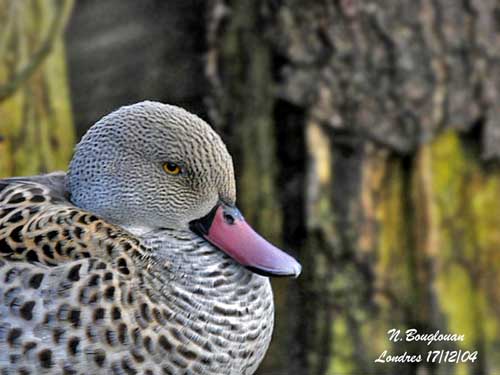
BEHAVIOUR:
The Cape Teal is usually seen in pairs or family groups, but they often gather in large numbers (up to several hundreds) for moulting.
During the day, it feeds on open shallow water, by dabbling, head-dipping, upending, or occasionally diving and swimming easily below the surface. It propels itself with legs and webbed feet, and with closed wings. It may feed on the shore too, filtering the mud thanks to the lamellas of its adapted bill.
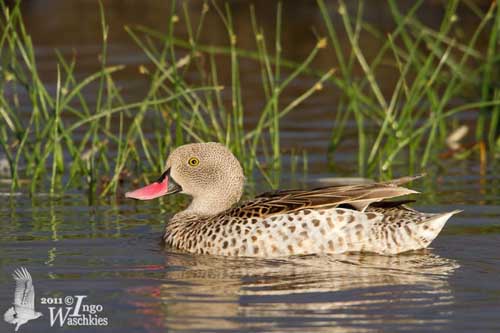
The Cape Teal may display throughout the year. It twists the neck and moves the head side to side. Or it runs quickly over the water surface and drawing semi-circles. The wings enhance the green speculums through adapted movements.
Both mates share these displays and other pairs often join them.
Their courtship behaviour may appear unusual sometimes, starting with mutual preening and followed by nods of the head. The male displays with raised head and tail, or with fanned tail and raised wings to display the green speculums, and ending by lowering the tail and pointing the bill towards the female. It may remain in this position while facing the female.
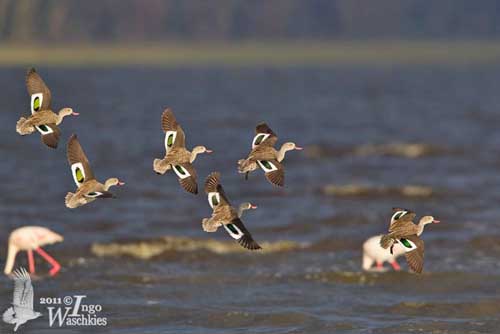
The Cape Teal is largely sedentary in its range, although it may wander largely during the droughts.
FLIGHT:
In flight, the Cape Teal appears really plumpish, with rather short neck and large head. It flies slowly, but it is agile and rapid when it has got started.
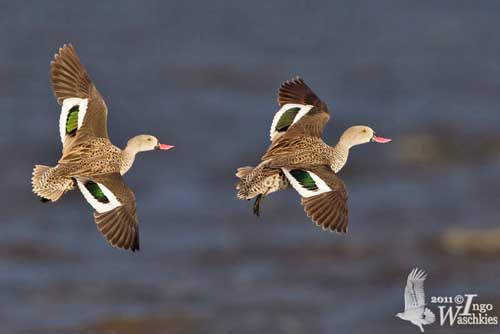
REPRODUCTION:
The breeding season varies according to the range and the rainfalls. The peak occurs between March and May in East Africa and between August and November in South Africa.
The Cape Teal nests solitary. The nest is built on the ground and hidden among the vegetation. It is often placed on island, and usually not far from water. This is a deep depression in the ground, with a thick lining of down.
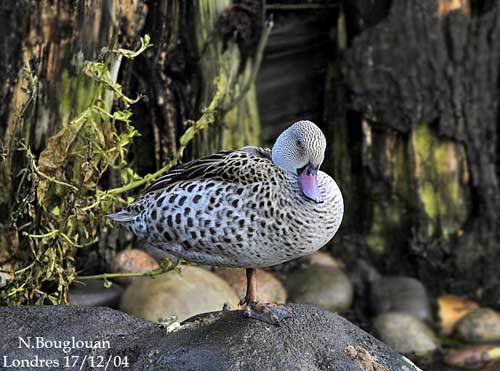
The female lays 6-11 fairly rounded, pale or orange eggs. She incubates during 26-30 days and hatching is synchronized. The chicks fledge about 8 weeks after hatching. Both parents share the nesting duties and strongly defend the chicks against predators. The young reach their sexual maturity at one year old.
The pair-bonds are strong and may last for the life.
DIET:
The Cape Teal feeds on invertebrates such as insects and their larvae, tadpoles, and seeds, leaves and stems of aquatic plants.
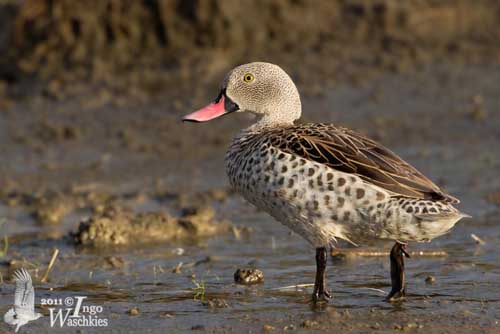
PROTECTION / THREATS / STATUS:
The species is widespread, and even locally common or abundant, although it appears patchily distributed and scarce in most of the range. In spite of the hunting pressure, the Cape Teal has benefited from numerous artificial dams and water bodies, and its populations are not currently threatened.
